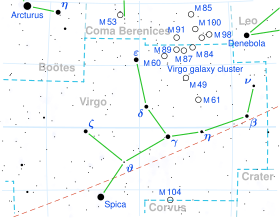astro.wikisort.org - Star
Rho Virginis (ρ Vir, ρ Virginis) is the Bayer designation for a star in the constellation Virgo. It has an apparent visual magnitude of +4.9,[2] making it a challenge to view with the naked eye from an urban area (according to the Bortle Dark-Sky Scale). The distance to this star has been measured directly using the parallax method, which places it 118.3 light-years (36.3 parsecs) away with a margin of error of about a light year.[1]
 | |
| Observation data Epoch J2000.0 Equinox J2000.0 | |
|---|---|
| Constellation | Virgo |
| Right ascension | 12h 41m 53.05658s[1] |
| Declination | +10° 14′ 51.1699″[1] |
| Apparent magnitude (V) | +4.88[2] |
| Characteristics | |
| Spectral type | A0 V[3] |
| U−B color index | +0.03[4] |
| B−V color index | +0.09[4] |
| Astrometry | |
| Radial velocity (Rv) | +1.6[2] km/s |
| Proper motion (μ) | RA: +82.67[1] mas/yr Dec.: –89.08[1] mas/yr |
| Parallax (π) | 27.57 ± 0.21 mas[1] |
| Distance | 118.3 ± 0.9 ly (36.3 ± 0.3 pc) |
| Absolute magnitude (MV) | +1.90±0.28[5] |
| Details | |
| Mass | 2.0[6] M☉ |
| Radius | 1.6[6] R☉ |
| Luminosity | 14[6] L☉ |
| Surface gravity (log g) | 4.36[7] cgs |
| Temperature | 8,930[6] K |
| Metallicity [Fe/H] | –1.00[7] dex |
| Rotational velocity (v sin i) | 154[8] km/s |
| Other designations | |
| Database references | |
| SIMBAD | data |
Rho Virginis is an A-type main sequence star with a stellar classification of A0 V.[3] It is larger than the Sun with a radius 60%[6] larger and about twice the mass. As such it is generating energy at a higher rate than the Sun, with a luminosity 14[6] times greater. The outer atmosphere has an effective temperature of 8,930 K,[6] which is what gives it the white-hued glow of an A-type star. It is classified as a Delta Scuti type variable star and its brightness varies by 0.02 magnitudes over periods of 0.5 to 2.4 hours.
This star has been established as a Lambda Boötis star that displays low abundances of iron peak elements. It displays an excess of infrared emission, but it is unclear whether this is being caused by a circumstellar debris disk or from the star passing through and heating up a diffuse interstellar dust cloud. Most likely it is the former,[6] in which case the dusty disk has a radius of around 37 AU and a mean temperature of 90 K.[9]
References
- van Leeuwen, F. (November 2007). "Validation of the new Hipparcos reduction". Astronomy and Astrophysics. 474 (2): 653–664. arXiv:0708.1752. Bibcode:2007A&A...474..653V. doi:10.1051/0004-6361:20078357. S2CID 18759600.
- Wielen, R.; et al. (1999), "Sixth Catalogue of Fundamental Stars (FK6). Part I. Basic fundamental stars with direct solutions", Veroeffentlichungen des Astronomischen Rechen-Instituts Heidelberg, Astronomisches Rechen-Institut Heidelberg, 35 (35): 1, Bibcode:1999VeARI..35....1W.
- Cowley, A.; et al. (April 1969), "A study of the bright A stars. I. A catalogue of spectral classifications", Astronomical Journal, 74: 375–406, Bibcode:1969AJ.....74..375C, doi:10.1086/110819.
- Johnson, H. L.; et al. (1966), "UBVRIJKL photometry of the bright stars", Communications of the Lunar and Planetary Laboratory, 4 (99): 99, Bibcode:1966CoLPL...4...99J.
- Paunzen, E.; et al. (November 2002), "The status of Galactic field λ Bootis stars in the post-Hipparcos era", Monthly Notices of the Royal Astronomical Society, 336 (3): 1030–1042, arXiv:astro-ph/0207488, Bibcode:2002MNRAS.336.1030P, doi:10.1046/j.1365-8711.2002.05865.x, S2CID 2389489.
- Martínez-Galarza, J. R.; et al. (March 2009), "Infrared Emission by Dust Around λ Bootis Stars: Debris Disks or Thermally Emitting Nebulae?", The Astrophysical Journal, 694 (1): 165–173, arXiv:0812.2198, Bibcode:2009ApJ...694..165M, doi:10.1088/0004-637X/694/1/165, S2CID 14298654.
- Sturenburg, S. (September 1993), "Abundance Analysis of Lambda-Bootis Stars", Astronomy and Astrophysics, 277 (1): 139, Bibcode:1993A&A...277..139S.
- Royer, F.; Zorec, J.; Gómez, A. E. (February 2007), "Rotational velocities of A-type stars. III. Velocity distributions", Astronomy and Astrophysics, 463 (2): 671–682, arXiv:astro-ph/0610785, Bibcode:2007A&A...463..671R, doi:10.1051/0004-6361:20065224, S2CID 18475298.
- Zuckerman, B.; Song, Inseok (March 2004), "Dusty Debris Disks as Signposts of Planets: Implications for Spitzer Space Telescope", The Astrophysical Journal, 603 (2): 738–743, arXiv:astro-ph/0311546, Bibcode:2004ApJ...603..738Z, doi:10.1086/381700, S2CID 3456817.
На других языках
- [en] Rho Virginis
[es] Rho Virginis
Rho Virginis (ρ Vir / 30 Virginis / HD 110411 / HR 4828)[1] es una estrella en la constelación de Virgo de magnitud aparente +4,87. Aunque actualmente no tiene nombre tradicional, en China recibía el título de Kew Heang, «los nueve oficiales del estado», en el cual se incluían algunas estrellas menores.[2] Se encuentra a 120 años luz de distancia del Sistema Solar.Другой контент может иметь иную лицензию. Перед использованием материалов сайта WikiSort.org внимательно изучите правила лицензирования конкретных элементов наполнения сайта.
WikiSort.org - проект по пересортировке и дополнению контента Википедии